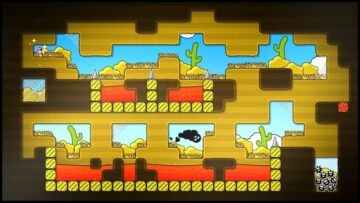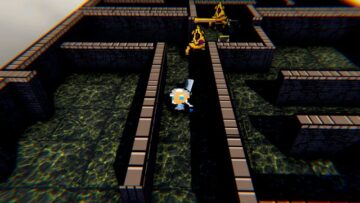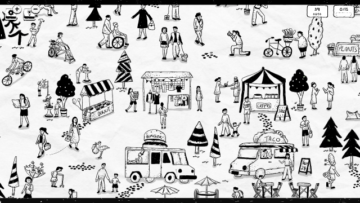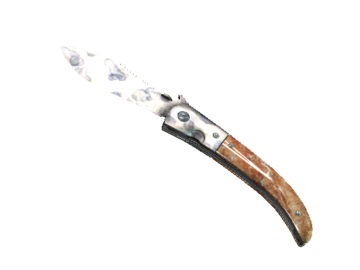We struggled for an adjective to describe Togges, until we landed on ‘eccentric’. It’s the perfect word to describe the sheer originality of its premise, coupled with the quirkiness of its humour. This is a thoroughly unique game. But that word ‘eccentric’ also carries something of a back-handed compliment: you would never trust someone who’s ‘eccentric’ to look after your kids, or to keep a secret. And in the same way, Togges lets us down, undoing so much of its good work with an avalanche of bad decisions.
Saying that, Togges really needs to be played. You might skip to that 3.5 out of 5 at the end and dismiss it entirely. But it’s one of those 3.5 experiences that feels borderline essential: an experience that you should really have for yourself. It’s one of those 3.5s that can’t be scored higher because the flaws are so glaring that you often can’t see the wood for the rotten trees. But it shoots for the stars so often, so repeatedly across its runtime, and it occasionally gets there.
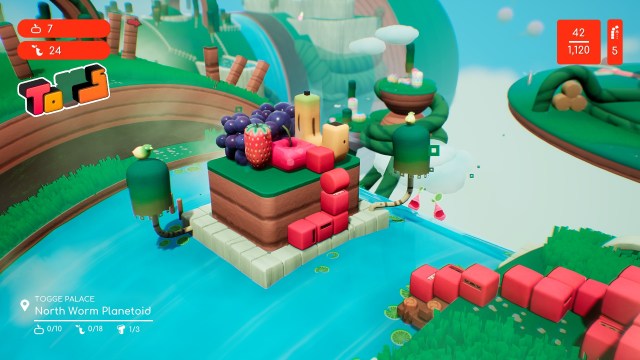
How do you describe a game like Togges? Okay, imagine that wherever you went, you left a trail of blocks behind you. You’d soon stop being invited to parties, that’s for sure. But that ability has uses: you can stand in one place, pooping out blocks so that they appear beneath you, stacking up to form some kind of tower. Now you’re high enough to reach lofty places – places you couldn’t reach before.
Now, imagine those blocks had properties. Maybe you plopped out red blocks, which carried the ability to set things on fire. Again, those party invitations would stop coming. But you could drop some blocks onto kindling and start a fire, or you could clear some brambles that blocked your path. Blue blocks could go underwater; orange blocks could conduct electricity; black blocks could survive any hazard you threw at them. The different-coloured blocks have different rules of stacking, too. Oranges can stack up to seven high; blue only three.
It would be handy, right? Particularly if you had a full block-box of them, able to whip them out whenever the situation demanded. Except Togges sets some rules that makes things a little more limited. For one, you can only connect blocks to other blocks of the same colour. You can’t suddenly produce blocks in the middle of nowhere: you need to be creating a chain link from a block that already exists. Now you have a puzzle: how do you get this orange block to that switch over there?
There’s a cap too. You can only have a set number of blocks in the environment at once. But Togges is something of a technical marvel, and you can actually have over a thousand blocks visible at once. How on earth this little game remembers every laid block, in exactly the right position, is beyond us. Still, you will be reaching that cap regularly, wondering what part of your chain can be abandoned so you can reach a new destination.
This is where another eccentricity comes in. You are a roomba. You can hover over blocks and suck them up with a press of LT. They’re stashed back in your library, so you can bank them for use elsewhere. And, being a roomba, the sucking power comes in useful for certain puzzles. Now you’re capable of stunning spinning tops, or powering fans. It’s yet another tool in the toolbox.

Got all that? We didn’t, at least not at the start. Togges has the unfortunate liability of being overloaded with tutorials, without any of them being up to snuff. You get to play two tutorials that cover exactly the same ground, and they still didn’t give us a frigging idea of what was going on. That’s because Togges has no chill: it’s determined to lay everything on you at once, without staggering its mechanics. We wished that Togges developer Regular Studio took a leaf out of Plants vs Zombies’ book (our go-to for perfect tutorialisation), and held back some of its ideas for latter levels. Or maybe keep them back entirely. Togges could easily have had three or four blocks and left it at that. Still we’d encourage you to persist, because Togges is a diamond in an awful lot of rough.
All of this block-laying and hoovering is ported over to Super Mario Galaxy. It’s the best comparison for Togges and its sheer ambition, sprawl and density.
You are presented with a galaxy that has planets for you to explore. The planets can be short and linear, with only a few fruit – the Super Mario Galaxy stars – to find. Or they can be gargantuan, offering fifty-or-so to gain. Think of a Super Mario Odyssey world, enlarge it by about fifty percent, and then you’re there. Now have thirty of the linear levels and seven of the larger levels, and you have a game that dwarfs most AAA titles.
Being inside a Togges level is overwhelming. Too overwhelming, in fact. It’s possibly the densest game we’ve ever played, with so many rewards, fruits, block colour-changers and more within a radius of only a few meters. It’s an incredibly acquired taste, something that you have to come to terms with pretty quickly. You need to take your time, plot a course to something that’s interesting, and then block out the rest of the noise. Focus on completing the task that you find – a dragon that needs waking, a scarecrow who wants you to clear his crows – and pursue it to the end. Once you have your fruit, you can move on to the next challenge.
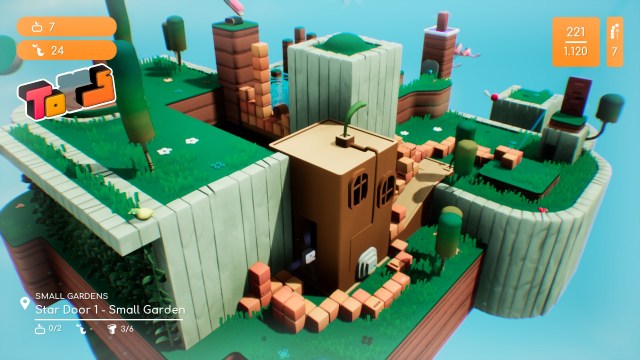
Togges is pretty clear that you need to explore for yourself. It’s on every loading screen, a desperate hand on your arm, telling you to be patient. Because we think Togges knows how high-maintenance it is. There are an awful lot of demands on the player, and we suspect – certainly by the sheer number of ‘rare’ achievements that we unlocked – that not many players have been willing to put in that work.
To give you an example, Togges is effectively a Metroidvania. You can reach the top of a skyscraper, putting in some monolithic effort to get there, only to find that you used the wrong coloured block. You needed an orange block, not red, to finish the puzzle. Cue the nibbling of controller cables.
You might reach your cube cap, but your options for retrieving your cubes are unnecessarily limited. You can hoover them up, one by one, with the roomba, but that means doing it manually and slowly. You can use an eraser, sporadically available in the levels, but they have a pitiful radius that makes them less useful than even the roomba. Or you can step through a star door, which is effectively a reset, but sometimes you don’t want a complete reset – you just want to remove the first cubes you placed. Is there a reason why erasing cubes is so arduous? Honestly, not really.
The largest of the issues is basic cube-laying. The rules around what can be placed where are unnecessarily obscure, with cubes able to span a single block’s width across chasms, yet knowing what counts as a chasm is a constant headache. Can you connect a bouncing block on a trampoline to one that’s on a higher platform? Can you put a block on a plane and then connect it to blocks that are close to the plane’s flight path? The answers are frequently yes, no or maybe, without much rhyme or reason to which.
And more and more idiosyncratic rules get layered on, until the brain swells and starts pushing at the edges of the skull. Why aren’t black blocks immune to dragonfire? Why is this platform destroying all of the blocks I place on it? Why am I not getting a reward when I fill this dotted line with cubes? We ended up asking more questions than a curious five-year old. Our only option was to keep calm and carry on. We didn’t need to find and gain every fruit in a level: it was fine to give up on occasion.
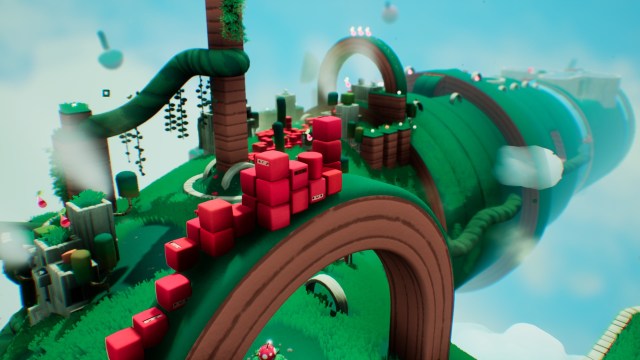
It was when we reached this nihilistic philosophy that Togges started to make sense. It doesn’t matter if you don’t unlock everything. It’s fine if you bypass an impenetrable problem. There are fifty fruit in a level, for frig’s sake: move on. It’s the message that should have been emblazoned on the loading screens, rather than hints about exploration. With that information, we might have gotten to the good stuff earlier. Because, by golly, we wanted to give up on it multiple times over.
Our relationship with Togges was an extremely imbalanced one. We had to put an awful lot of effort into overcoming its control issues, fiddly rules, poor camera, nonsensical dialogue and more. As relationships go, this is a needy one, and we can’t convincingly report whether it’s worth the effort.
What we do know is that if you commit and push past the numerous problems, Togges is one of the most original and stupendously generous games you will find, this year or any year. We suspect some people might even make it their game of the year (or game of last year: we’re late to the party). It’s Super Mario Galaxy on a roomba, with some of Nokia’s Snake thrown in for good measure. Now, if that’s not enough to tease you in, nothing ever will.
You can buy Togges from the Xbox Store
TXH Score
3.5/5
Pros:
- Unbelievable large and densely filled with secrets
- Completely unique. Nothing is like it
- We keep on returning to it, finding more fruit
Cons:
- Poorly tutorialised and unfriendly
- Has far too many rules and complications
- Story, camera and controls all carry problems
Info:
- Massive thanks for the free copy of the game go to – Thunderful
- Formats – Xbox Series X|S, Xbox One, PS4, PS5, Switch, PC
- Version reviewed – Xbox Series X
- Release date – 7 December 2022
- Launch price from – £16.99
- SEO Powered Content & PR Distribution. Get Amplified Today.
- Platoblockchain. Web3 Metaverse Intelligence. Knowledge Amplified. Access Here.
- Source: https://www.thexboxhub.com/togges-review/
- :is
- $UP
- 1
- 100
- 7
- 70
- a
- AAA
- ability
- Able
- About
- achievements
- acquired
- across
- actually
- After
- AI
- All
- already
- ambition
- and
- Another
- answers
- appear
- ARE
- ARM
- around
- AS
- At
- available
- Avalanche
- back
- Bad
- Bank
- basic
- BE
- because
- before
- behind
- being
- BEST
- Beyond
- Black
- Block
- blocked
- Blocks
- Blue
- book
- Brain
- buy
- by
- cables
- camera
- CAN
- cap
- capable
- carry
- Carry On
- certain
- certainly
- chain
- challenge
- chasm
- clear
- Close
- come
- coming
- commit
- comparison
- completing
- Conduct
- Connect
- constant
- content
- control
- controller
- controls
- could
- coupled
- course
- cover
- Creating
- curious
- Date
- December
- decisions
- demanded
- demands
- density
- describe
- destination
- determined
- Developer
- dialogue
- Diamond
- different
- Dismiss
- Doesn’t
- doing
- Dont
- Door
- down
- Dragon
- Drop
- Earlier
- earth
- easily
- effectively
- effort
- electricity
- elsewhere
- encourage
- enough
- entirely
- Environment
- essential
- Even
- EVER
- Every
- everything
- exactly
- example
- Except
- exists
- experience
- Experiences
- exploration
- explore
- extremely
- fans
- far
- few
- fill
- filled
- Find
- finding
- fine
- finish
- Fire
- First
- flaws
- flight
- Focus
- For
- form
- Free
- frequently
- from
- Fruits
- full
- Gain
- Galaxy
- game
- Games
- generous
- get
- getting
- Give
- Go
- going
- good
- Ground
- hand
- handy
- Have
- Held
- High
- higher
- hints
- Honestly
- hover
- How
- http
- HTTPS
- i
- idea
- ideas
- in
- incredibly
- information
- interesting
- issues
- IT
- ITS
- jpg
- Keep
- kids
- Kind
- Know
- Knowing
- large
- larger
- largest
- Last
- Last Year
- Late
- layered
- Lets
- Level
- levels
- liability
- Library
- like
- Limited
- Line
- LINK
- little
- loading
- lofty
- Look
- Lot
- make
- MAKES
- manually
- many
- Mario
- marvel
- Matter
- max-width
- means
- measure
- mechanics
- message
- metroidvania
- Middle
- might
- Monolithic
- more
- most
- move
- multiple
- Need
- needed
- needs
- New
- next
- Noise
- number
- numerous
- occasion
- occasionally
- of
- offering
- Okay
- Old
- on
- ONE
- Option
- Options
- Orange
- original
- originality
- Other
- part
- particularly
- parties
- party
- past
- path
- patient
- PC
- People
- percent
- perfect
- philosophy
- Place
- Places
- Planets
- plants
- platform
- plato
- Plato Data Intelligence
- PlatoData
- Play
- played
- player
- players
- poor
- position
- power
- Powering
- presented
- press
- pretty
- price
- Problem
- problems
- produce
- properties
- ps4
- PS5
- Push
- Pushing
- put
- Putting
- puzzle
- Puzzles
- Questions
- quickly
- rather
- rating
- reach
- reached
- reaching
- reason
- Red
- regular
- regularly
- relationship
- Relationships
- remove
- REPEATEDLY
- report
- REST
- returning
- review
- reviewed
- Reward
- Rewards
- Roomba
- rules
- sake
- same
- Screen
- screens
- Secret
- sense
- Series
- SERIES X
- set
- Sets
- seven
- Short
- should
- single
- situation
- skyscraper
- Slowly
- So
- some
- Someone
- something
- Soon
- span
- stack
- stacking
- stand
- Star
- Stars
- start
- started
- starts
- Step
- Still
- Stop
- studio
- Stunning
- Super
- survive
- Switch
- Take
- Task
- taste
- Technical
- terms
- that
- The
- their
- Them
- There.
- things
- Think
- this year
- thoroughly
- three
- Through
- time
- times
- titles
- to
- too
- tool
- Toolbox
- top
- Tops
- Tower
- Trees
- Trust
- tutorials
- underwater
- unfortunate
- unique
- unlock
- unnecessarily
- us
- use
- visible
- vs
- wanted
- Way..
- What
- whether
- which
- WHO
- will
- willing
- with
- within
- without
- wondering
- Word
- Work
- world
- worth
- would
- Wrong
- X
- xbox
- Xbox One
- xbox series
- Xbox Series X
- year
- Your
- yourself
- zephyrnet



